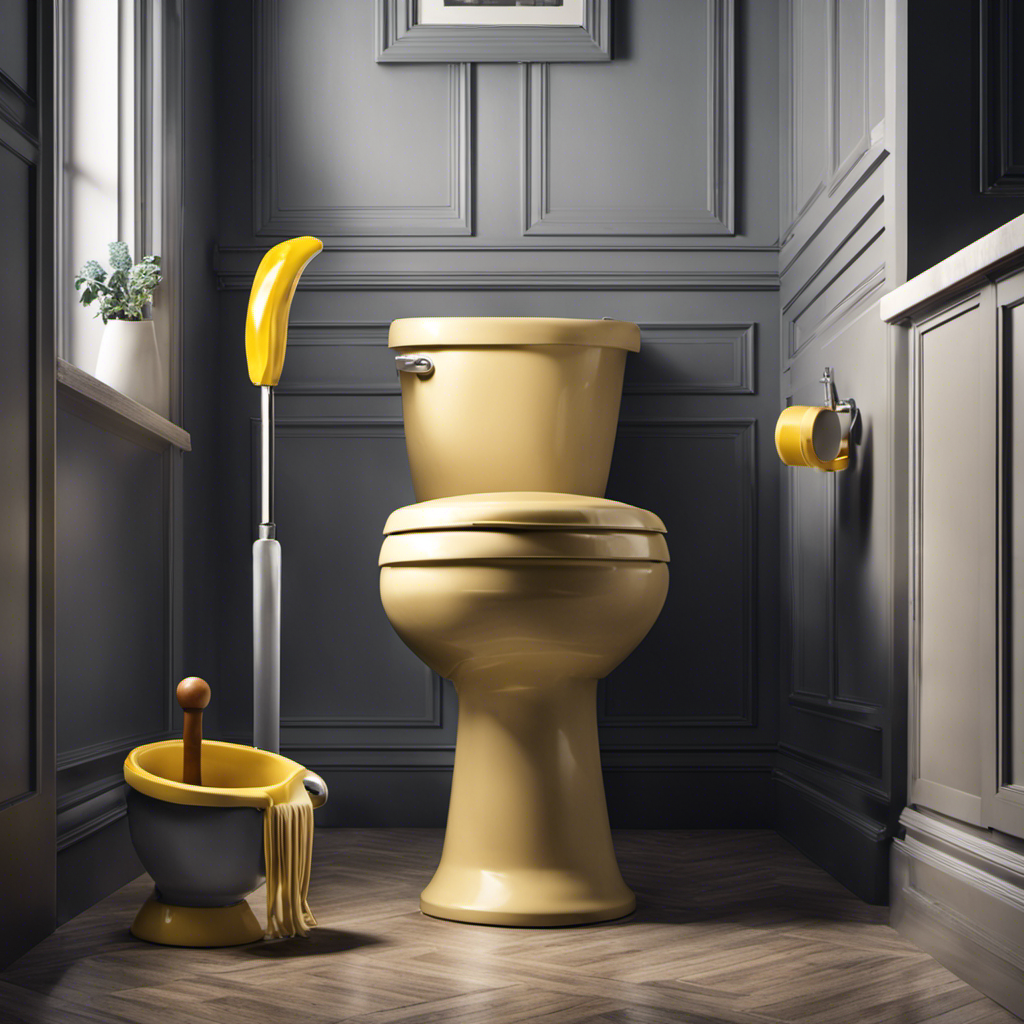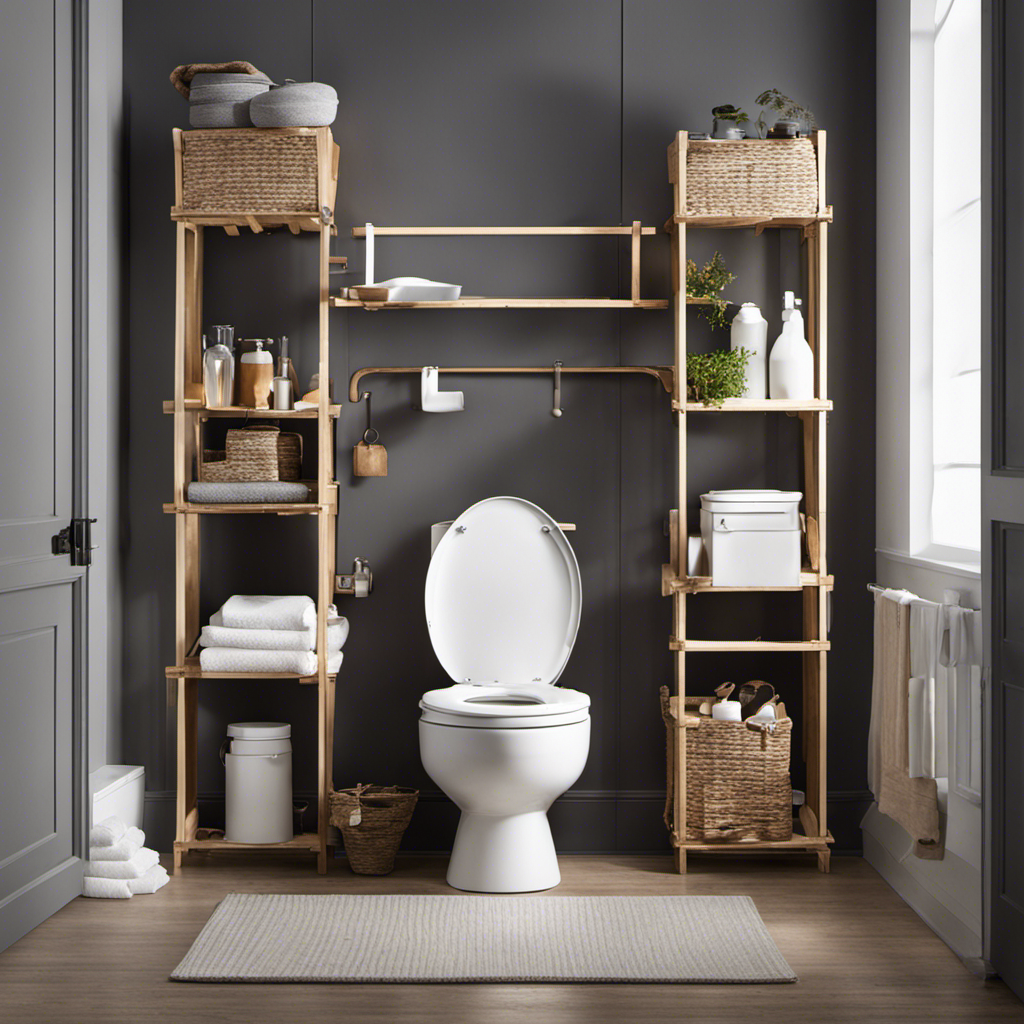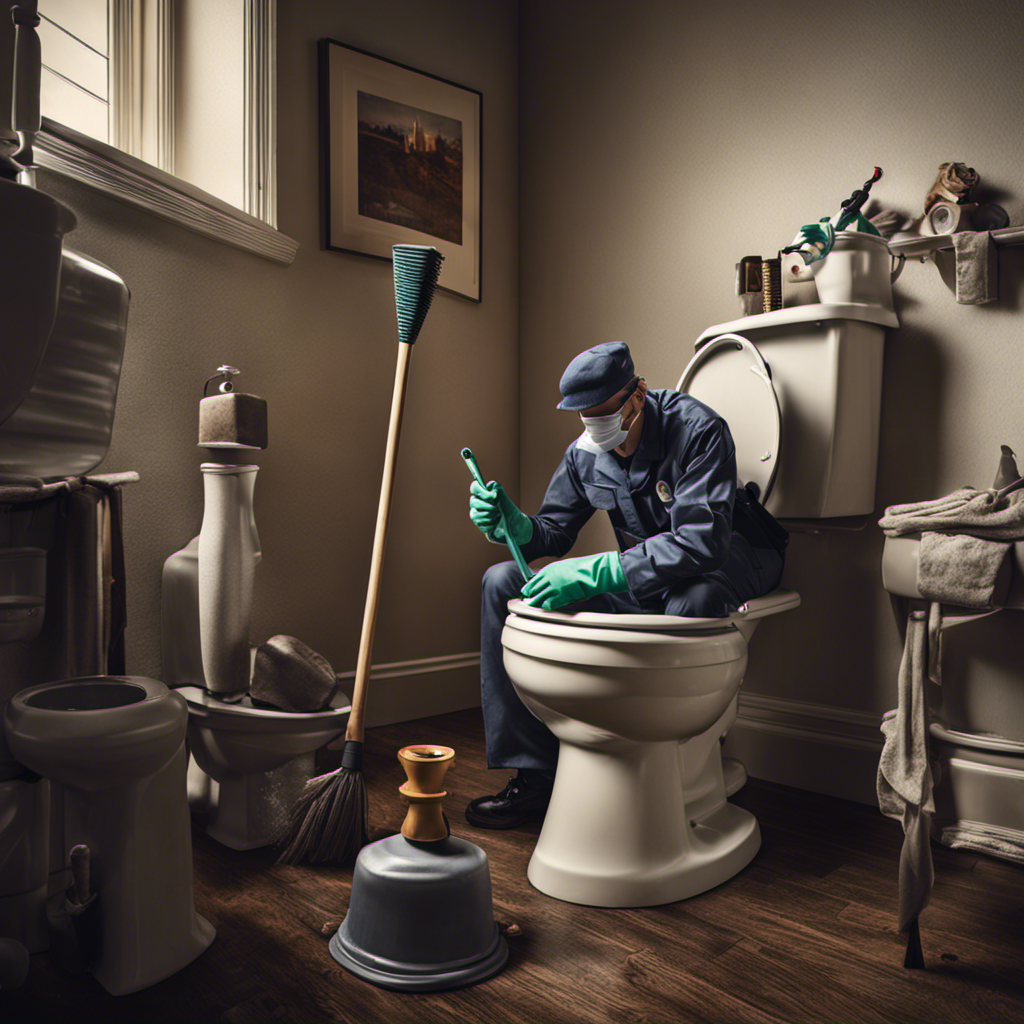Hey there!
Did you know that a clogged toilet is one of the most common household plumbing issues? Well, fear not! In this article, I’m going to guide you through the step-by-step process of unclogging your toilet.
With just a few simple tools and a little know-how, you’ll be able to tackle this problem like a pro.
So, let’s get started and get that toilet flowing smoothly again in no time!
Key Takeaways
- Gather the necessary tools: plunger, toilet auger, rubber gloves, and a bucket.
- Use a plunger with a flange for a better seal and suction.
- If the plunger doesn’t work, use a toilet auger to break up the clog.
- Flush the toilet with a bucket to ensure complete clearance.
Tools You Will Need
You’ll need a plunger to unclog your toilet. This essential tool is designed to create pressure and dislodge the blockage in your toilet’s pipes.
When choosing a plunger, opt for a toilet plunger with a flange, as it provides a better seal and more effective suction.
To use the plunger, start by positioning it over the drain hole in the toilet bowl. Press down firmly and then pull up quickly to create suction. Repeat this motion several times until the water starts to drain.
If the plunger doesn’t work, you may need to use an auger. An auger is a flexible tool that can reach deeper into the pipes to remove stubborn clogs. Insert the auger into the drain and rotate it to break up the blockage.
Step-By-Step Process for Unclogging a Toilet
Start by gathering the necessary tools and supplies for the step-by-step process of unclogging a toilet. Here are the tools you will need: a plunger, a toilet auger, rubber gloves, and a bucket.
Once you have everything ready, follow these troubleshooting tips to unclog your toilet.
First, put on the rubber gloves to protect your hands.
Next, use the plunger to create a seal around the toilet drain and push and pull forcefully to dislodge the clog.
If the plunger doesn’t work, use the toilet auger by inserting it into the drain and turning the handle clockwise to break up the clog.
Finally, use the bucket to flush the toilet and ensure the clog is completely cleared.
Remember to clean and sanitize your tools afterwards.
Common Causes of Toilet Clogs
One of the common causes of toilet clogs is flushing excessive amounts of toilet paper at once. To prevent toilet clogs, it’s important to be mindful of how much toilet paper you flush down the toilet. Instead of flushing large amounts at once, try to flush smaller, more manageable amounts.
Another common cause of toilet clogs is flushing non-flushable items such as wipes, feminine hygiene products, or paper towels. These items can easily get stuck in the pipes and cause blockages. To prevent this, it’s important to only flush toilet paper and waste.
If you do encounter a clogged toilet, there are DIY methods you can try before calling a plumber. These methods include using a plunger, a toilet auger, or a mixture of hot water and dish soap.
Tips for Preventing Future Clogs
Regular maintenance practices and proper flushing techniques are essential for preventing future toilet clogs.
Maintaining a regular cleaning schedule helps to remove any build-up and keeps the toilet functioning properly.
Additionally, using proper flushing techniques, such as flushing only toilet paper and avoiding flushing non-flushable items, can help prevent clogs from occurring in the first place.
Regular Maintenance Practices
To keep your toilet flowing smoothly, it’s important to regularly maintain it. Regular maintenance practices can help prevent clogs and keep your toilet clean and in good working condition. Here are some steps you can take to maintain your toilet:
-
Clean the toilet bowl: Use a toilet brush and cleaner to scrub the inside of the bowl and remove any stains or buildup. This will help prevent clogs caused by debris or mineral deposits.
-
Check the flapper and flush valve: Inspect the flapper and flush valve for any signs of wear or damage. Replace them if necessary to ensure proper flushing and prevent clogs.
-
Clear the jet holes: Use a thin wire or needle to clear any debris or mineral deposits from the jet holes under the toilet rim. This will help maintain a strong flush and prevent clogs.
-
Avoid flushing non-flushable items: Remind everyone in your household to only flush toilet paper and waste down the toilet. Avoid flushing items like baby wipes, sanitary products, or paper towels, as they can easily cause clogs.
-
Conduct regular inspections: Periodically check for any leaks or signs of damage around the toilet. Addressing these issues promptly can prevent future clogs and more serious plumbing problems.
Proper Flushing Techniques
Make sure you’re using enough water when you flush, as this will help prevent clogs in your toilet.
To troubleshoot toilet flushing problems, it’s important to understand proper flushing techniques. Follow these steps for an efficient flush:
-
Firstly, press the flush lever fully down to release the water. If the tank doesn’t empty completely, you may need to adjust the chain or flapper valve.
-
Next, make sure the water level in the tank is at the correct height. Adjust the float or fill valve if necessary.
-
Lastly, check the flush holes under the rim of the bowl. Use a toilet brush to clear any buildup that may be blocking the flow of water.
Alternative Methods for Unclogging a Toilet
Sometimes you just need a different approach to unclog your toilet. When the usual methods fail, there are some toilet unclogging hacks and natural remedies for clogged toilets that you can try. Here are five alternative methods to help you get the job done:
-
Baking Soda and Vinegar: Pour a cup of baking soda into the toilet bowl, followed by a cup of vinegar. Let it sit for a few minutes, then flush the toilet.
-
Hot Water: Boil a pot of water and pour it into the toilet bowl. The hot water can help break up the clog and clear the drain.
-
Dish Soap: Squirt a generous amount of dish soap into the toilet bowl. Let it sit for a while, then flush and see if the clog is gone.
-
Plunger and Plastic Bag: If you don’t have a plunger, you can use a plastic bag. Place the bag over the drain, push down firmly, and then pull up quickly to create suction.
-
Wire Hanger: Straighten out a wire hanger and use it to break up the clog. Insert it into the drain and move it around to dislodge any debris.
These alternative methods can be effective in unclogging your toilet without the need for harsh chemicals or plumbing tools. Give them a try before calling a professional plumber.
When to Call a Professional Plumber
If you’re experiencing persistent clogs or other plumbing issues, it may be time to call a professional plumber. While there are many DIY methods to try first, sometimes the problem is beyond your expertise. Knowing when to DIY and when to call a professional is crucial to avoid further damage or costly repairs.
Here are some signs of a serious clog that indicate it’s time to bring in a professional. Firstly, if you’ve tried multiple DIY methods without success, it’s a clear indication that the clog is stubborn and requires professional attention.
Secondly, if you notice water backing up in multiple drains or toilets simultaneously, it could be a sign of a larger issue in your plumbing system that needs professional expertise.
Lastly, if you smell foul odors or notice sewage coming up through your drains, it’s a serious issue that requires immediate professional assistance. Remember, it’s always better to be safe and call a professional plumber when you’re unsure about fixing a plumbing problem.
Conclusion
In conclusion, unclogging a toilet can be a messy and frustrating task, but with the right tools and steps, you can tackle it like a pro.
Just like navigating through life’s obstacles, sometimes we encounter clogs that seem impossible to overcome. However, by taking a systematic approach and applying the right techniques, we can clear the way and find a solution.
So next time you face a clogged toilet, remember that with a little determination and know-how, you can conquer any blockage that comes your way.










